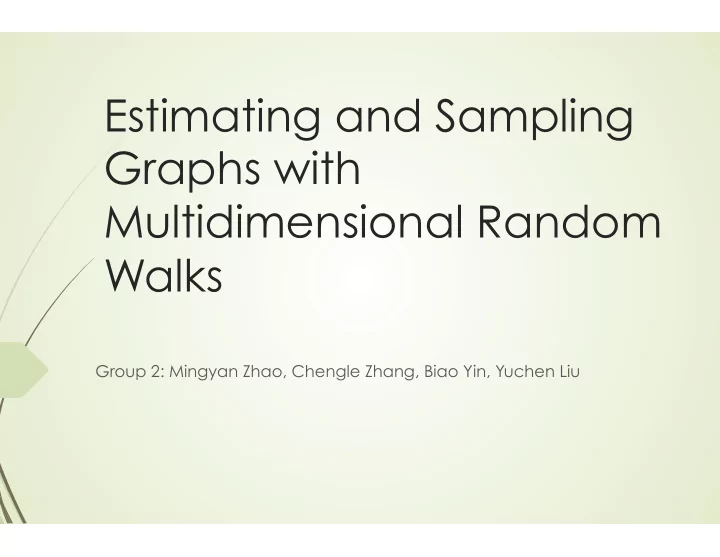

Estimating and Sampling Graphs with Multidimensional Random Walks Group 2: Mingyan Zhao, Chengle Zhang, Biao Yin, Yuchen Liu
Motivation Complex Network Social Network Biological Network eference: www.forbe.com imdevsoftware.wordpress.com
Existing Approaches ´ Random vertex sampling ´ Random edge sampling ´ Random walks
Frontier Sampling ´ a new m -dimensional random walk that uses m dependent random walkers.
Contribution ´ Mitigates the large estimation errors caused by disconnected or loosely connected components. ´ Shows that the tail of the degree distribution is better estimated using random edge sampling than random vertex sampling. ´ Presents asymptotically unbiased estimators
Definitions Notation Meaning G d (V, E d ) A labeled directed grap representing the (origina network graph, where V is set of vertices and Ed is a set of edges (u, v) A connection from u to (a.k.a. edges) L v and L e Finite set of vertex and edg labels, L e (u,v) = ∅ Edge (u, v) is unlabeled L v (v) = ∅ Vertex v is unlabeled
Vertex V.S. Edge Sampling
Section 4 1. Mathematical theories and conductions on Random Walk Sampli 2. Strong Law of Large Numbers 3. Four estimators will be applied in Section 5 4. Deficiency of RW 5. Multiple Independent Random Walkers
Strong Law of Large Numbers B Number of RW steps Original statistical Thm: B*(B) Number of edges in E* Total RW Sampled Weak law: Edges
Estimator 1: Edge Label Density st, label edges of interest: , the probability of the labelled edges e estimator based on SLLN
Estimator 2: Assortative Mixing Coefficient (AMC) nsidering directed G, an asymptotically unbiased estimator of AMC: Covariance Which two are highly correlated?
Estimator 3:Vertex label Density Construct an asymptotically unbiased estimator: Since: So, this estimator converges to:
Estimator 4: Global Clustering Coefficient e unbiased estimator by SLLN ce:
Deficiency of RW from one point 1. “Trapped” inside a subgraph (MSE) 2. Start from non-stationary (non-steady) state (MSE, Bias) Burn-in period: Discard the non-stationary samples 1. Just decrease error with non-stationary one 2. Discarding in a small sample is not ideal Multiple Independent Random Walkers come!
Single RW and Multiple RW Still very high Single RW is depend on sample sizes from the estimators provided. Mutiple RW will split the sample sizes into each path. So, error in the total CNMSE Log-log plot!
Why not M-independent RW ? MIRW is hard to sample A m independent vertex with p proportional to their degrees. B
Section 5 Motivation ´ We want an m-dimensional random walk that, in steady state, samples edges uniformly at random but, unlike MultipleRW, can benefit from starting its walkers at uniformly sampled vertices.
Frontier Sampling p = deg( 𝑣 ) /∑𝑀↑▒ deg( 𝑤 ) * 1 / deg( 𝑣 ) =
Frontier Sampling: A m-dimensional Random Wa ´ The frontier sampling process is equivalent to the sampling process of a single random walker over 𝐻↑𝑛 . (Lemma 5.1) ´ P(selecting a vertex and its outgoing edge in FS) = P(randomly sampling an edge from e( 𝑀↓𝑜 ) in single random walker over 𝐻↑𝑛 ).
FS Steady State v.s Uniform Distribution ´ 𝐿↓𝑔𝑡 (𝑛) be a random variable that denotes the number of random walkers in 𝑊↓𝐵 in steady state. ´ Let 𝐿↓𝑣𝑜 ( 𝑛 ) be a random variable that denotes the number of sampled vertices, out of m uniformly sampled vertices from V, that belong to 𝑊↓𝐵 . ´ Proving this to be true indicates that the FS algorithm starting with m random walkers at m uniformly sampled vertices approaches the steady state distribution. This means FS benefits from starting its walkers at uniformly sampled vertices by reducing transient of RW.
FS Steady State V.S. Uniform Distribution ´ By definition ´ Theorem 5.2 ´ Lemma 5.3 ´ Theorem 5.4
MultipleRW Steady State V.S. Uniform Distribution ´ 𝐿↓𝑛𝑥 ( 𝑛 ) be a random variable that denotes the steady state number of MultipleRW random walkers in 𝑊↓𝐵 . Note: 𝑒↓𝐵 (average degree of vertices in 𝑊↓𝐵 ) Conclusion: If we initialize m random walkers with uniformly sampled vertices, FS starts closer to steady state than MultipleRW.
Distributed Frontier Sampling ´ Frontier Sampling can also be parallelized. ´ A MultipleRW sampling process where the cost of sampling a vertex v is an exponentially distributed random variable with parameter deg(v) is equivalent to a FS process. (Theorem 5)
Experiment and Result ´ Data: ´ “Flickr”, “Livejournal”, and “YouTube” ´ Barabási-Albert [5] graph ´ Goal: ´ Compare FS to MultipleRW, SingleRM ´ Compare FS on random vertex and edge sampling ´ Result: FS is constantly more accurate
Assortative Mixing Coefficient
In-degree Distribution Estimates
Out-degree Distribution Estimates
In-degree Distribution loosely connected components ´ Barabási-Albert Graph
FS V.S. Stationary MultipleRW & SingleRW ´ MultipleRW and SingleRW start with steady state
FS V.S. Random Independent Sampling
Density of Special Interest Group
Global Clustering Coefficient Estimates ´ Global Clustering Coefficient a measure of the degree to which nodes in a graph tend to cluster together.
Conclusion ´ In almost all of the tests, FS is better. Future Work • estimating characteristics of dynamic networks • design of new MCMC-based approximation algorithms
Thank you!
Recommend
More recommend